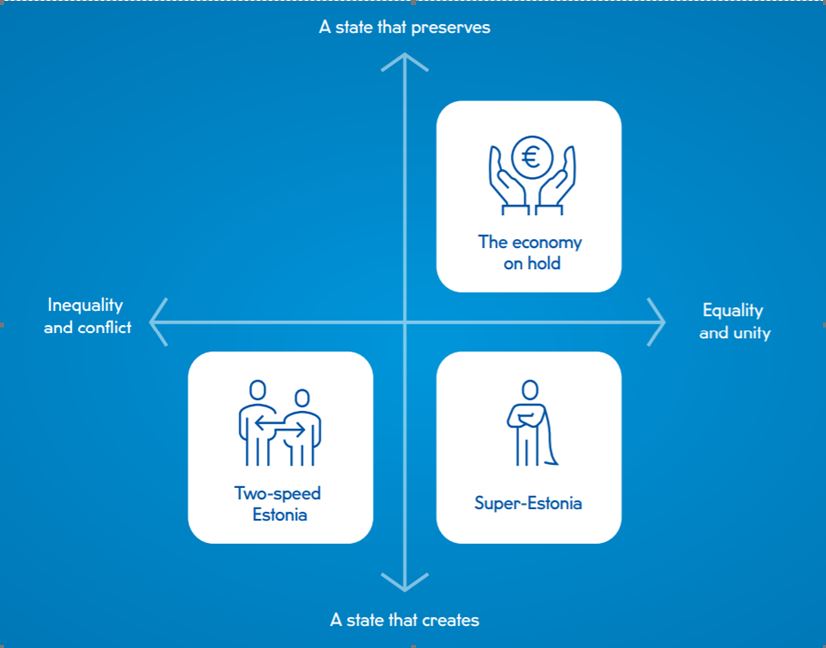The impact of the virus crisis on the Estonian economy. Scenarios up to 2030
Foresight Centre developed three scenarios about the impact of the virus crises on the Estonian economy untill 2030.
The crisis for the economy is a multilateral one:
- people who are ill and in self-isolation cannot work or create value as they normally would,
- the restrictions introduced to combat the virus are preventing the economy from functioning normally, and
- the uncertainty caused by the crisis is affecting how people, companies and the government are behaving and will behave in future.
Sectors that are better proofed against the virus, notably information and communications, wood and paper production, and the financial sector, will increase in importance. Start-up companies will also benefit if the outlook is favourable, as there is a lot of money around the world searching for investment opportunities.
The virus crisis has accelerated several trends in the economy:
- the creation of more resilient value chains and working processes,
- digitisation and automation, and
- increased use of remote working and virtual communications.
The crisis will widen the material and technological inequalities in society. New forms of inequality will arise, such as inequality in digital literacy and in the ability to work remotely.
The further course of the virus crisis and how it affects the economy and society may cause developments to move in quite different ways. By combining the main trends, we can produce three possible scenarios for what might come next:

The economy on hold
Top priority is given to preserving existing companies and jobs and preventing social conflicts from worsening, and where the main support is given to large and strategically important companies so that growth in the economy can recover.
Two-speed Estonia
The main focus of economic policy falls on the capacity for spontaneous renewal from the crisis. Hope is placed in the appearance of new business models and an expansion of the hi-tech sector. Efforts are made to keep spending on social policy under control to avoid harming the business environment.
Super-Estonia
The crisis is used to spark a renewal of the economy, on the condition that the gains and losses are spread fairly across the layers of society, and agreement is reached in other areas where important decisions have to be made about the quality of life in Estonia, such as the use of natural resources. The priority is to upgrade the economy and infrastructure in line with the digital and green agendas of the European Union.
The scenarios highlight two central points of decision in economic policy.
1. Find a balance between revitalising the economy and preserving companies:
• Use subsidies to save existing companies that have been hurt largely by the restrictions the government introduced, and hope that once the crisis passes they will be able to continue in business and gradually make the structural changes needed. The danger is that there is less capacity for renewal in the economy, and mergers, acquisitions and increased state participation end up reducing competition.
• Direct resources to revitalising the economy and helping the companies that are best able to adapt to make leaps forward in their development. The risk is that companies that are successfully able to adapt may not take the whole economy with them, and may not be able to compensate enough for those that disappear because of the crisis.
2. Find a balance between the need to keep the state budget under control, and the social tensions caused by increasing inequalities:
• Use more generous support than so far to stop social conflicts rapidly escalating. The state debt would grow rapidly in this case.
• Find options for retraining and try to empower people through policies that promote entrepreneurship, with the aim of phasing out support schemes.
• Prioritise above all the capacity of the economy for self-regulation and avoid letting social policy overwhelm the state budget, while avoiding raising taxes but encouraging job creation by keeping state finances orderly and the business environment competitive.
Author: Uku Varblane, expert, Foresight Centre

 An independent think tank at the Riigikogu
An independent think tank at the Riigikogu